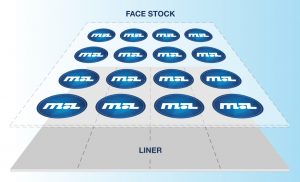Digital Multi-Layer Converting Capabilities Explained
Should a single die station limit your ability to run work that requires multi-layer cutting? Absolutely not! At Mark Andy, we specialize in solutions and we’re here to help you get the most out of your equipment.
Are you wondering how multi-layer cutting can this be done with one single die station? Take a look at the below images for a straightforward “how-to” to better maximize your short-run digital machine.
Our partners in the die manufacturing industry have mastered the science behind multi-level tool fabrication. You can purchase a single multi-level die that is capable of cutting to different layers of the web. Chief among the advantages that multi-level dies offer is the fact that you’re only purchasing a single die to do the work of two or more, which saves you money, time and storage space.

The die on top cuts the labels from the top while the die on the bottom simultaneously cuts the perf into the liner from the bottom. This method allows the operator to easily strip away the non-perforated waste matrix of the face material without having to worry about matrix breaks.
Another significant advantage is the fact that there are fewer tools to register which equals less set-up time and waste during each job. Although the process of multi-level die cutting can – and should be – very simple, stripping the waste matrix in this scenario can prove to be a challenge as the liner will tend to break at the perforation. Thankfully there’s a solution for that as well.
A better way to achieve the desired result is to use two single level cutting dies that are stacked in the die station. The die on top cuts the label shape from the top while the die on the bottom simultaneously cuts the perf into the liner from the bottom. This method allows the operator to easily strip away the non-perforated waste matrix of the face material without having to worry about matrix breaks. To achieve this, our engineers at Mark Andy change the height of the die station to accommodate an additional cylinder. We also made the anvil run in reverse since the undercutting die will now be running on top of it which will cause the material entering the die station to deflect back out.
Mark Andy’s custom design team and application engineers are constantly striving to improve each of our offerings, whether based on customer feedback, market trends or advancements in technology. As a Total Solutions Partner, we pride ourselves on providing converters the tools they need even when they’re not sure it’s possible.
This is just another benefit of the versatility brought to converters by True Hybrid technology. The hybrid aspects provide capabilities that are simply not available with conventional digital presses. So if you find yourself turning down jobs because something doesn’t seem feasible, be sure to ask your Mark Andy rep for an application consultation first.